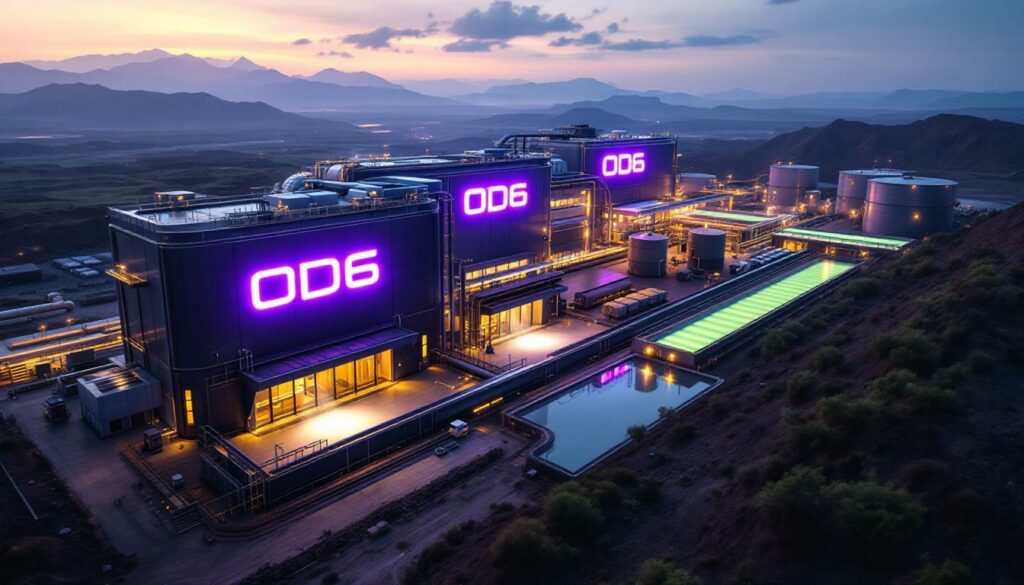Game-Changing Nanofiltration Tech Slashes Acid Costs by 84.5% at Splinter Rock Rare Earth Project
OD6 Metals nanofiltration breakthrough has achieved a major efficiency milestone at its Splinter Rock Rare Earth Project, with the innovative technology dramatically reducing acid requirements by over 80% – a development set to transform the project economics.
Revolutionary Acid Recovery Reshapes Project Economics
The Australian Nuclear Science and Technology Organisation (ANSTO) has completed nanofiltration testwork that delivered 84.5% acid recovery while maintaining 94% rare earth element retention in the concentrated solution destined for further processing.
"Acid was anticipated to be one of our top three operating costs, alongside power and labour. Achieving an +80% reduction in acid consumption dramatically improves the project's cost structure," said Managing Director Brett Hazelden.
This breakthrough is particularly significant for Splinter Rock, which hosts Australia's largest and highest-grade clay-hosted rare earth deposit with a JORC Mineral Resource of 682Mt @ 1,338ppm TREO, including an Indicated Resource of 119Mt @ 1,632ppm TREO.
Beyond acid recovery, the nanofiltration process delivers additional critical benefits:
- 69% reduction in liquid volume sent to the Impurity Removal (IR) Circuit
- Smaller downstream equipment requirements, reducing both capital and operating costs
- No loss of rare earth elements during the acid recovery process
Inside Centre: The Cornerstone Deposit
OD6 is focusing development on the Inside Centre area, which will serve as the cornerstone deposit with significant advantages:
- 119Mt @ 1,632ppm TREO Indicated Resource
- 79% MagREE heap leach recoveries (compared to 56% in tank leach tests)
- Consistently high recoveries of valuable magnet rare earths:
- Neodymium (Nd) & Praseodymium (Pr): ~80% recovery
- Dysprosium (Dy): 60% recovery
- Terbium (Tb): 70% recovery
| Element | Recovery Rate |
|---|---|
| Nd & Pr | ~80% |
| Tb | 70% |
| Dy | 60% |
The heap leach recoveries continue to increase even after 80 days of leaching, suggesting potential for further optimisation with longer duration leach cycles.
Understanding Nanofiltration: A Game-Changing Technology
Nanofiltration (NF) is a pressure-driven membrane filtration process that selectively separates substances based on size and charge. It sits between reverse osmosis and ultrafiltration in terms of pore size and selectivity, making it ideal for the selective recovery of acids like hydrochloric acid (HCl).
Nanofiltration works by applying pressure to force a solution through a membrane with pores that are typically between 1-10 nanometres in size. These membranes are designed to allow certain molecules and ions to pass through while retaining others. In the case of OD6's application, the OD6 Metals nanofiltration breakthrough allows hydrochloric acid to pass through the membrane (known as the "permeate") while concentrating the rare earth elements and impurities on the other side (the "retentate").
Key advantages in mining applications include:
- Selective HCl recovery with specialised membranes
- Lower energy consumption through decreased downstream circuit size
- Low-maintenance, potentially recyclable membranes
- Robust systems suitable for remote operations
- Modular design allowing for easy expansion
The testwork conducted by ANSTO demonstrated that when operating at 38 bar pressure with commercially available membranes, the nanofiltration system achieved remarkable results:
- 84.5% of the hydrochloric acid was recovered in the permeate, which can be recycled directly back to the heap leach process
- 94% of rare earth elements were retained in the concentrated solution
- The volume of solution requiring further processing was reduced by 69%
These results indicate that nanofiltration technology could significantly enhance the economic viability of clay-hosted rare earth projects by addressing one of the major cost components – acid consumption.
Heap Leaching Simplifies Processing
OD6's shift from tank leaching to heap leaching has already eliminated the need for leach tanks, thickeners, and complex solid-liquid separation infrastructure. This change:
- Significantly reduces capital expenditure
- Lowers operating costs through simpler processes
- Produces clearer leach liquor, making it ideal for nanofiltration
- Decreases water requirements
"With our switch from tank – which is being implemented by some Brazilian-based peers – to heap leaching, we've already eliminated the need for leach tanks, thickeners, and complex solid-liquid separation infrastructure. This simplification reduces both capital and operating costs significantly," noted Hazelden.
The heap leaching process involves stacking crushed ore material on an impermeable pad and irrigating it with an acidic solution that percolates through the heap, dissolving the rare earth elements. The resulting pregnant leach solution is then collected for further processing.
OD6's heap leach tests on the Inside Centre material have demonstrated exceptional results, with magnet rare earth recoveries of 79% – significantly higher than the 56% achieved in tank leach tests. Particularly noteworthy are the high recoveries of the most valuable rare earth elements: neodymium and praseodymium at approximately 80%, terbium at 70%, and dysprosium at 60%.
With the addition of nanofiltration, the company has created a streamlined, efficient processing flowsheet that maximises rare earth recovery while minimising costs.
Future Work and Timeline
OD6 is currently finalising additional testwork at ANSTO focused on:
- Impurity removal trials under various conditions
- Ion exchange assessment for selective REE elution
- Mixed rare earth precipitation options
An Optioneering Study by CPC Engineering is underway to integrate these results into a preferred flowsheet, with completion expected this quarter.
The next steps for the project include:
- Finalisation of impurity removal testwork
- Assessment of ion exchange processes for selective rare earth element elution
- Investigation of mixed rare earth precipitation methods
- Development of process models and techno-economic comparisons
- Mini pilot scale testing using composited bulk samples
These activities are expected to further refine the processing flowsheet and provide additional data for economic evaluation of the project.
Why Investors Should Watch OD6 Metals
The OD6 Metals nanofiltration breakthrough represents a significant competitive advantage for OD6 in the rare earth sector. With acid consumption previously expected to be one of the top three operating costs, this 84.5% reduction transforms the project economics.
Key investment highlights include:
- Australia's premier clay-hosted rare earth project with the largest and highest-grade resource
- Innovative processing solutions that dramatically reduce costs
- High recoveries of valuable magnet rare earths (Nd, Pr, Tb, Dy) that are critical for EV motors and wind turbines
- Substantial growth potential with current resource covering <10% of tenement area
- Strong management team with extensive experience in critical minerals
The successful integration of nanofiltration technology into OD6's rare earth processing flowsheet represents a pivotal advancement that could position Splinter Rock as one of the most economically attractive rare earth projects globally.
With the global demand for rare earth elements continuing to grow, particularly for magnet rare earths used in electric vehicles and renewable energy technologies, OD6 Metals appears well-positioned to capitalise on this opportunity with its innovative approach to rare earth processing.
Ready to Invest in the Future of Rare Earth Processing?
Discover how OD6 Metals is revolutionising rare earth production with their game-changing nanofiltration technology that slashes acid costs by 84.5% at the Splinter Rock Project. As Australia's largest and highest-grade clay-hosted rare earth deposit continues to deliver breakthrough results, now is the time to explore this investment opportunity. Visit OD6 Metals' website to learn more about their innovative approach and how they're positioned to meet the growing global demand for critical rare earth elements.




